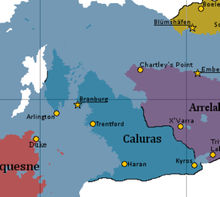Caluras
| The Kingdom of Caluras | ||||
|---|---|---|---|---|
|
||||
| Motto: "Progress is inevitable, it is best to get ahead" |
||||
National Map
|
||||
| Capital and largest city | Branberg | |||
| Official languages | Caluran(91%) Other(9%) | |||
| Ethnic groups (2018 Estimate) | Caluran(93%) Other(7%) | |||
| Demonym | Caluran | |||
| Government | Parliamentary Constitutional Monarchy | |||
| - | King | Hadrian Ardan | ||
| - | Chancellor | Barric Fossoway | ||
| - | High General | Frederick Durwell | ||
| - | Minister of Foreign Affairs | Maldon Casswell | ||
| - | Minister of Domestic Affairs | Karlon Florent | ||
| Legislature | Federal Senate | |||
| Population | ||||
| - | Jan. 2018 estimate | 22,430,000 | ||
| GDP (nominal) | 2018 estimate | |||
| - | Total | $455,329,000,000 | ||
| - | Per capita | $20,300 | ||
| Currency | Foron ц (CAL) |
|||
| Date format | MM/DD/YYYY | |||
| Drives on the | the right | |||
| Calling code | +96 | |||
| ISO 3166 code | CAL | |||
| Internet TLD | .cal | |||
The Kingdom of Caluras, more commonly known as Caluras is an old, but proud nation, located in the far north-western corner of the Yasterian continent, comprised of the entirety of the Ashan peninsula, the Saffron island chain, and the eastern portion of the island of Skarnor. Caluras borders the nation of Arrelak to the east, the Borean sea to the North, and the Yasterian sea to the west and south.
History
Age of Antiquity
The modern nation of Caluras may be fairly new, but the land's history stretches back thousands of years. Sarnean culture had already existed for thousands of years, with archaeological sites containing objects from 10,000 BC. But the first records of civilization date back to around 3,500 years BC in a region of Caluras called “the Reach”, with the formation of a confederation of farming hamlets along the river Sarne, in northern Caluras. As time went on, the hamlets expanded into villages and towns, and new settlements along the river sprouted up. Trade and commerce stayed within the boundaries of the confederation, which came to be known simply as the Sarnean Civilization, and was led by a council of chieftains from each village and town. In 2,900 BC, records tell of the Sarneans coming into contact with a people from a neighboring river plain along the river Mander. Both sides initially believed the foraging parties to be bandits and hostility broke out, but a second encounter had better results and the two civilizations began to trade and cooperate. Due to the Sarnean population being much larger than the inhabitants of the Mander, and after much migration, the settlements along the Mander, now predominantly Sarnean, joined the Sarnean Confederation.
This civilization continued to expand, absorbing small hamlets and villages, and founding new outposts along the river. The confederation council was responsible for all aspects of administration, and even formed a militia force if levies from the many towns in the land. But, this system ended around 1000 BC, when the militia led a coup against the council and took control of the Confederation through force. This coup happened to coincide with the outbreak of Blackscale Plague, a deadly virus originating somewhere far south of Caluras, near central Yasteria. This virus wiped out half of the population of the region, and led to 50 years of chaos and instability. An entire generation of people born and killed in this time of turmoil.


